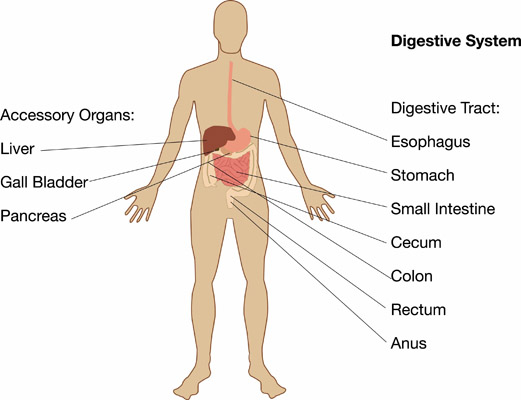 username@email.com
username@email.com

The mouth prepares food for entry into the GI tract. The lips, cheeks, and tongue work together to place food between the teeth for chewing. The teeth begin the process of mechanical digestion, which is the physical breaking up of food. While the teeth cut and grind food into a pulp, the salivary glands secrete the first digestive enzymes of the GI tract. Saliva has three functions:
At this point, the food is swallowed. As the tongue moves the food into the pharynx, it presses down on the epiglottis. The epiglottis will close entry to the respiratory tract and guide the food to the GI tract.
The food will next pass down the 25cm tube that connects the pharynx to the stomach, the esophagus. Rings of muscles line the walls of the esophagus. The esophagus acts as a kind of descending escalator, moving food down to the stomach. It does this by rhythmic waves of muscular contractions called peristalsis. A thick ring of muscle called a sphincter is found where the esophagus and stomach join. The sphincter usuall prevents acid-soaked food from moving back up into the esophagus.
The stomach is a thick muscular sac located just below the diaphragm in the abdomen. It temporarily stores food and mechanically breaks down food. It also chemically unravels and breaks down proteins. Three sets of glands in the stomach lining secrete gastric fluids. The stomach mixes its contents with a churning action. The mixture of food, hydrochloric acid (HCl), and enzymes eventually forms a soupy, semisolid material called chyme.
One set of glands produces mucus, which keeps the food lubricated and protects the walls of the stomach from being digested. Another set of glands secretes hydrochloric acid (HCl), which helps break down food. The release of HCl is regulated by the hormone, gastrin. A third set of glands secretes pepsin, a digestive enzyme that breaks proteins into smaller polypeptides.
The pyloric valve between the small intestine and the stomach opens and the food is forced into the small intestine by peristalsis. At this point, most proteins have been broken down, but sugars and fats have not been chemically altered. Some starch molecules remain as well.
The muscle contractions that move food down the esophagus are called
Hope you chose D, because peristalsis is the rhythmic waves of contractions that move food down the esophagus and through the pyloric valve. Chyme is produced in the stomach. Amylase is an enzyme in the mouth. Gastrin is a hormone that regulates the release of HCI in the stomach.
Food passes through the pyloric valve into the small intestine, which is approximately 6m long. The first part of the small intestine is called the duodenum. Here, the chyme is flooded with a variety of enzymes and digestive fluids that further break down the food molecules. The enzymes and digestive enzymes come from three sources: the small intestine, pancreas, and liver.
Glands lining the duodenum release enzymes called peptidases, which continue the process of protein digestion. Other enzymes attach to complex carbohydrates, breaking them down into sugars.
When chyme enters the small intestine, glands in the pancreas are stimulated to release pancreatic fluid. The fluid enters a duct that empties into the duodenum. Enzymes in the fluid aid in digestion of carbohydrates, fats, and proteins. The enzymes include amylase, protease, and lipase. Pancreatic fluid also contains sodium bicarbonate, which neutralizes the hydrochloric acid in the chyme.
Diagram of villi of the small intestine
As food enters the small intestine, the liver is stimulated to release bile through the bile duct into the duodenum. Bile is a yellow-brown liquid that is stored in the gall bladder. Bile does not contain enzymes. It is a mixture of cholesterol, colored pigments, and bile salts. Bile salts aid lipase in properly digesting fats.
The complete digestion of carbohydrates, fats, and proteins takes place in the duodenum, which is the first 25 cm of the small intestine. The rest of the small intestine is devoted to absorbing water and products of digestion into the bloodstream. The lining of the small intestine is covered with fingerlike projections called villi, which increase the absorptive surface area of the small intestine. The average surface area is about 300 sq meters.
When the food leaves the small intestine, it is basically nutrient-free. Only water, cellulose, and other indigestible substances are left. Then, the food passes into the large intestine, or colon. The large intestine is about 1m long, but it is about 3 times larger than the small intestine in diameter. Instead of being coiled up, the colon is in three relatively straight segments. The main job of the colon is to remove water from the undigested materials passing through it. The undigested material is then reduced to solid waste products called feces. No digestion takes place in the large intestine.
The feces move through the colon by peristalsis and collect at the rectum. At some point, the feces will leave the body through the anus.
It is important to note that many enzymes aid in the digestion process. Here is a short list:

The part of the digestive system in which digested materials are absorbed is the
The correct choice is B. Villi and macrovilli in the small intestine absorb nutrients. The digestive process begins in the mouth. The large intestine removes water from undigested materials. The stomach breaks food particles down for later absorption.